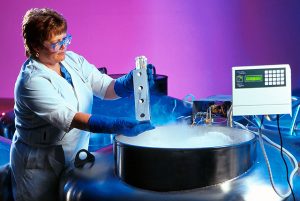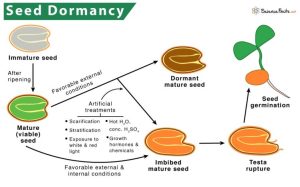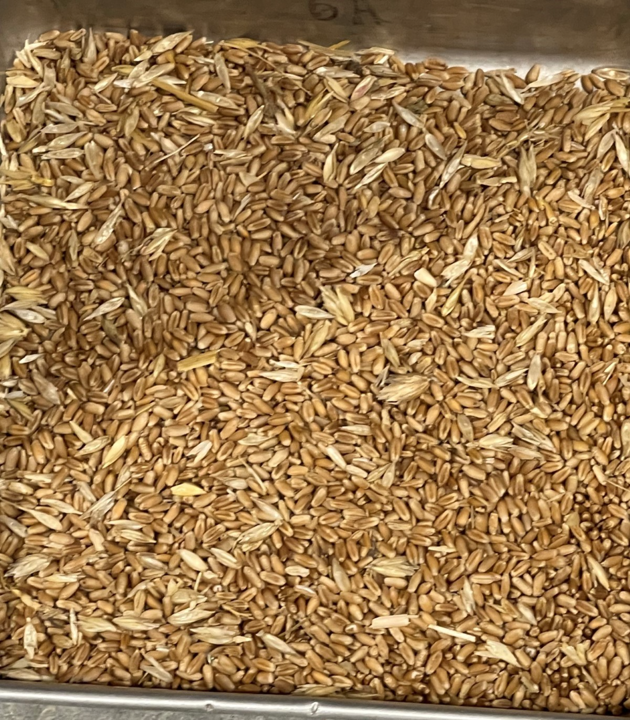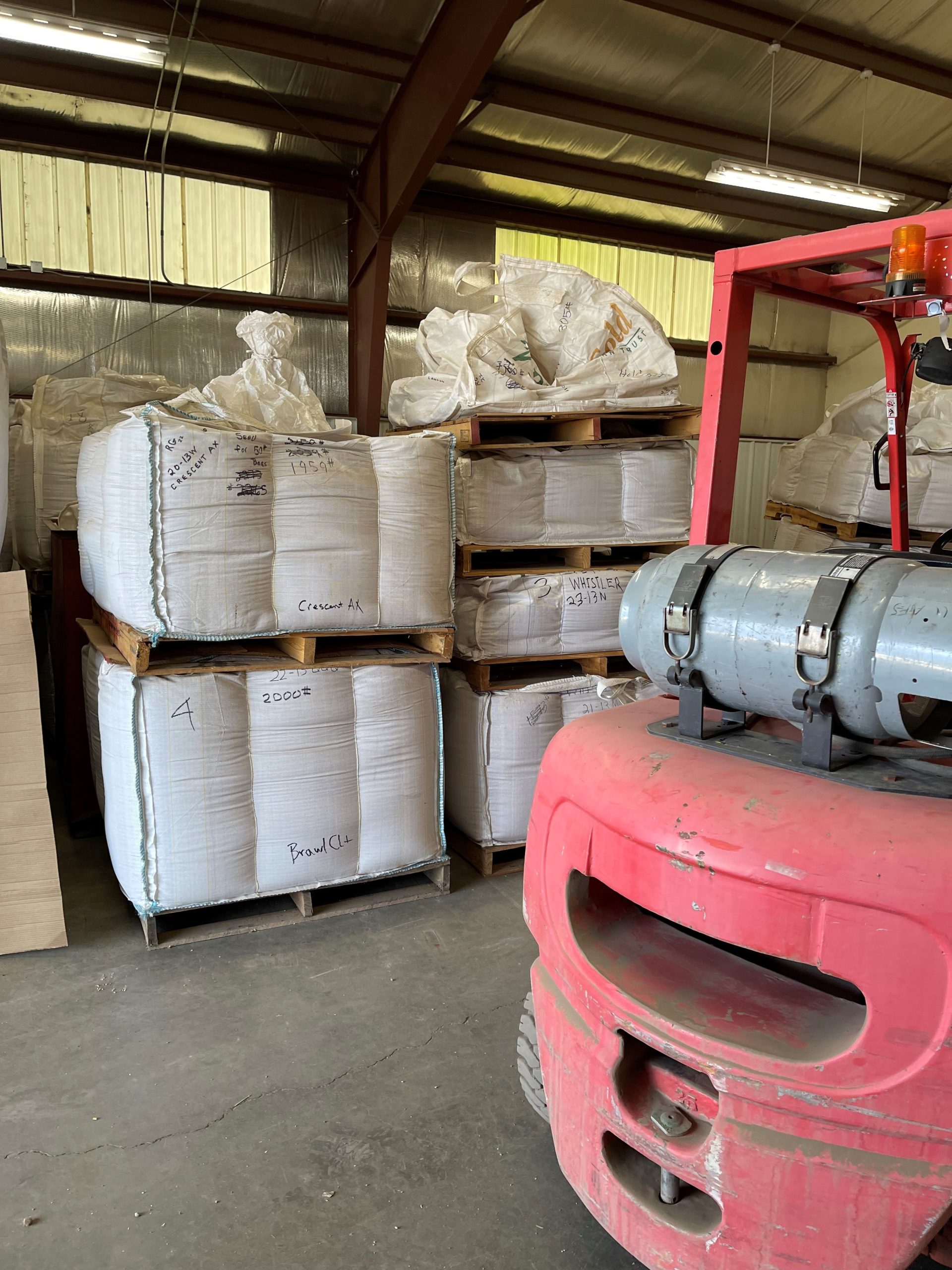6.2 – Dormancy, Orthodox and Recalcitrant Seeds
Storing Seeds

Photo by USDA Scott Bauer.
Our agricultural systems have evolved over the years to rely on storing seeds to preserve planting stocks from one season to the next. One of the most important reasons for storing seeds today is to accumulate desired genetic stocks for years following those of low production, called carryover seed.
- Short term storage of seeds for 10 years or less remains a significant practice.
- Long term storage (more than 20 years) is also desirable for genetic preservation programs.
The ability of humans to save and store seeds for prolonged time periods is due much in part to the inherent trait of seed dormancy.
Ultimately short- and long-term storage of seed has one goal: to delay seed deterioration.
Dormancy
The ability of humans to save and store seeds for prolonged time periods is due much in part to the inherent trait of seed dormancy.
Seed dormancy is defined as a physical or physiological condition of a viable seed that prevents germination even in the presence or otherwise favorable germination conditions. In other words, it is a complex resting stage influenced by genetics, environment and preharvest factors.
Dormancy traits set seed apart from nearly all other forms of life, a characteristic that evolved over time as a protective or survival measure of a species so that not all seeds germinate at the same time and therefore not all seeds are subject to a potential catastrophic event that may lead to population extinction. However, the ability to manipulate seed dormancy is thought to have led to the development of agriculture. The image below from Science Facts illustrates both external and internal conditions must be present for a seed to break dormancy and germinate.

Seeds can become dormant during formation and maturation in two ways.
The first is called primary or endogenous dormancy.
- Is triggered by genetic factors or other conditions that induce seed dormancy during the development and maturation of the seed itself.
- Primary or endogenous dormancy is the most prevalent dormancy found in seeds due to inherent properties of the seed.
- For example, the seed may possess an excess of inhibitors that must be removed or reduced prior to germination by freezing or leaching with water.
The second way is called secondary dormancy and occurs after the seed has reached maturity.
- In secondary dormancy a non-dormant seed exposed to an environmental condition such as heat or drought, may become dormant at that time, to survive the unfavorable condition.
- This is also referred to as exogenous dormancy, or a condition in which the essential germination components (water, light, and temperature) are not available to a viable seed and it fails to germinate, but remains viable, waiting for the right conditions to appear.
The length of time seed will be able to be stored will be dependent on seed species, quality of seed and how it is handled. Seed species have been separated further into 3 categories based on how long they can be stored based on the biology of their biology. These categories are Orthodox seed, Recalcitrant seed, and Intermediate seed. Click on each below to learn more.

View the linked video (2 mins) for a discussion of how seed dormancy in black grass (weeds) impacts control strategies in crops.
Storage Condition Considerations
It is the composition of the seed that will determine the appropriate atmospheric conditions needed for optimum long-term storage. Recalcitrant seeds have a much higher moisture content than do orthodox seeds at physiological maturity. They do not tolerate cold temperatures or loss of moisture content. As a result, recalcitrant seeds are not able to be stored for long periods of time, they do not enter dormancy and do not tolerate low temperatures, because ice crystals will form when the water held within the seed freezes and breaks cell membranes.
Causes of Seed Deterioration
Seed deterioration is an inevitable and irreversible event. Seeds can deteriorate or lose their viability over time due to various factors which can affect their ability to germinate. Seed deterioration is a significant consideration in agricultural production.
Estimates have been made that about 25% of the annual value of seeds in inventory are lost because seeds deteriorate, leading to poor seed quality.
Some of the primary causes of seed deterioration include the following, click on each to learn more:
Seed Moisture Content, Humidity, and Temperature

Temperature and relative humidity are the two most important factors influencing the longevity of seeds and are interrelated. As temperature decreases in a storage facility, moisture in the air is released, because warm air holds more moisture than cold air. Seeds are hygroscopic, meaning they will absorb the moisture in the air.
In 1972 Harrington[1] proposed a ‘Rule of Thumb’ pertaining to storage stating that the longevity of a seed is decreased by ½ for each 5 degree C increase in seed storage temperature and for each 1% increase in seed moisture content. This rule of thumb is only true for storage conditions greater than 0 C and below 50 C.
The purpose of seed storage at minimum is to preserve seeds from one season to the next. Seeds of most orthodox species (like wheat and other crop seeds) can be stored for several years by carefully controlling the temperature and relative humidity.
For short term storage (less than 3 years) another general ‘rule of thumb’ is that the sum of the relative humidity and temperature should not exceed 100. For example, most seeds can be stored unsealed for short term at 50 F and 50% relative humidity.
Preserving seeds for the longest duration possible without sacrificing viability is ultimately the goal.
Depending on the length of storage needs, the value of the seed and the genetic makeup of the seed, longer term storage can be achieved by reducing temperatures to subzero (-10 to -20 C) and by placing seed in a moisture -proof container. Ultimately seeds will need to be dried and subject to cooler temperatures for optimum long-tern storage.
Drying is an essential step in seed storage and helps maintain high quality seed. In the drying process excess moisture is removed so that the seed can be stored at a constant temperature and moisture regardless of the length of storage to maintain seed viability.
Review
Work through these interactive questions to review the important concepts discussed.

Earn an industry recognized micro-credential at: CSU Upskill.
Seed that is held in inventory from one growing season to the next. It can still be used if its viability and vigor remain acceptable.
The storage of seeds for a shorter period, typically less than a year, where viability is maintained without the need for strict environmental controls.
The practice of storing seeds for extended periods, often in controlled environments with low humidity and temperature, to preserve seed viability.
A state in which seeds are unable to germinate even under favorable environmental conditions, often as a survival mechanism to delay germination until conditions are optimal.
The process by which seeds lose their viability and vigor over time due to environmental factors, such as temperature, humidity, and seed aging.
Seeds that are alive but temporarily unable to germinate, even when environmental conditions are favorable.
Seeds that can be dried to low moisture levels and stored for long periods under cool, dry conditions without losing viability.
Seeds that cannot tolerate drying and lose viability when their moisture content drops below a certain level. They must be stored in moist conditions and are usually short-lived.
Seeds that have a moderate tolerance to drying and low temperatures, and therefore require careful storage conditions to maintain viability.
The state of the atmosphere at a specific place and time, including factors like temperature, humidity, wind, and air pressure, which can impact seed growth and storage.
The biological membranes that separate the interior of a cell from the external environment, regulating the passage of substances in and out of the cell.
Seed that is alive; seed that can grow; containing structures and substances including enzyme systems that give it germination potential.
The process of growing crops and raising animals for food, fiber, biofuel, and other products used to sustain human life.
A measure of the amount of water vapor in the air relative to the maximum amount the air can hold at a given temperature, expressed as a percentage. It influences seed moisture content during storage.
The ability of a substance (such as seeds) to absorb moisture from the air.
